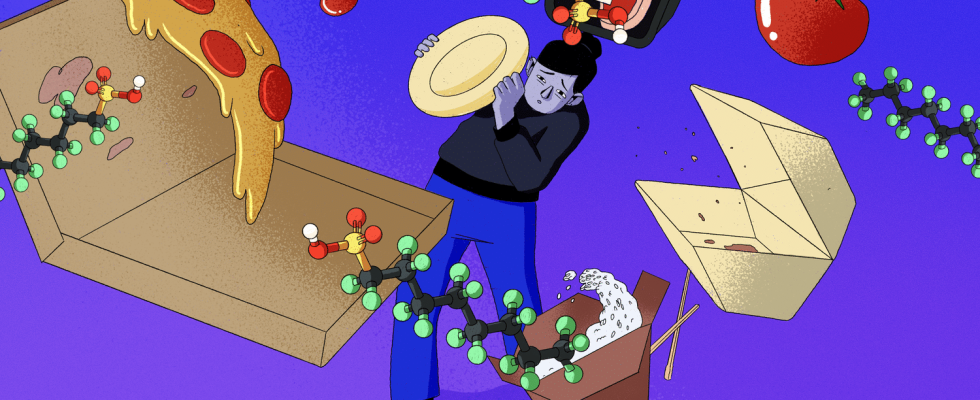Environmentalists are presenting a bill to ban PFAS from products in contact with food, before their ban in packaging in the European Union. Such a text alone would not be enough to eliminate them.
PFAS (pronounced “piface”) are often referred to as “perennial pollutants.” More rarely, it is emphasized that these are also omnipresent pollutants. Originating from chemistry, these molecules have contaminated everyday life by imposing themselves in the composition of everyday objects: plastics, textiles, coatings, paints, medicines, pesticides, etc. Taking advantage of the “parliamentary niche” of the environmentalist group in the National Assembly, the Gironde deputy Nicolas Thierry presented Thursday April 4 a bill aimed at protecting the risks linked to the growing exposure of the population to these substances from the family of perfluoroalkylated and polyfluoroalkylated. The text proposes in particular to ban them for any product in contact with food, from July 2025.
Packaging, fish trays, pastry papers… In the making of these everyday products, “perfluorinated compounds are mainly used for their hydrophobic properties”explains chemist and toxicologist André Cicolella, president of the Environmental Health association.
“Because they repel water and fat, we find them for example in pizza boxes. Typically, these boxes have a slightly glossy appearance.”
André Cicolella, toxicologistat franceinfo
“But there are actually several thousand types of possible uses”, continues the environmental health researcher. To target this point of contamination, the bill discussed Thursday proposes to get a little ahead of the European regulation which in March enacted the ban by 2026 on adding polyfluoroalkyls to the composition of food packaging.
For André Cicolella, the recent attention paid to perfluorinated compounds – by both legislators and the media – has made these molecules chemical enemy number 1. “We must of course act in the face of widespread contamination by PFAS. But from a chemical point of view, what is crucial is to ban endocrine disruptors”he insists. “However, in this large family, there are PFAS, but also bisphenols and phthalates, which can always be used”he warns.
“It doesn’t make sense to separate PFAS from other equally harmful endocrine disruptors.”
André Cicolella, chemistat franceinfo
If the text proposed to the Assembly only concerns perfluorinated substances, European legislation on packaging does not provide for the ban on bisphenol-A, although originally demanded by MEPs. However, these bisphenols, like phthalates, are molecules dissolved more quickly by the body than PFAS, known as “eternals”notes André Cicolella. “By banning these endocrine disruptors which are also found everywhere, we will obtain results more quickly than by acting on PFAS, even if we must act on all contaminations in a complementary manner.”
Contaminated water and land
If the law is passed, the elimination of PFAS from the composition of materials in contact with food does not mean that these molecules will stop contaminating food. And for good reason: fruits and vegetables, cereals, meat and dairy products… Everything we ingest can “be contaminated by soil or water itself contaminated and used to grow these foods”explains the European Food Safety Authority.
This contamination of water, air and land is the subject of great attention today, but requires setting threshold limits, which are sometimes difficult to establish. “Health authorities, water agencies, research laboratories, communities… Many stakeholders closely monitor environmental contamination with various substances, particularly PFAS”assures chemist Hélène Budzinski, specialist in chemical pollution of all kinds in the environment.
As for the‘Anses, it is already working to develop “maximum concentration values to be respected in environments, particularly aquatic environments”we can read in the ministerial action plan on PFAS, unveiled in January 2023 by Christophe Béchu, the Minister of Ecological Transition. “The aim is to give greater visibility to activities causing significant discharges (industrial sites, urban wastewater treatment plants)”, the document continues. In the viewfinder: the cases of large-scale industrial pollution, such as in the Rhône, where the metropolis of Lyon took the Arkema and Daikin chemical factories to court.
A ministerial decree taken on June 20, 2023 requires 5,000 installations classified as environmental protection to monitor these PFAS in their aqueous discharges. Charged by the government with a mission on these substances, the centrist deputy Cyrille Isaac-Sibille called for “urgently stop industrial discharges” containing “eternal pollutants”, “without waiting for European restrictions”.
Also present in pesticides
“Eternal pollutants” can also take another route to end up on our plates. End of February, Pesticide Action Network Europe and Future Generations have warned of contamination of food products with PFAS through pesticides containing these molecules, on the basis of reports transmitted to the EU by the Twenty-Seven. “The number of European fruits and vegetables in which PFAS pesticide residues were detected almost tripled between 2011 and 2021, with a growth rate of 220% for fruits and 247% for vegetables”revealed the two NGOs in a report (PDF).
In November, these same NGOs noted that “12% of all synthetic substances approved in Europe” for agricultural use are PFAS. Thus, they deplore the fact that the latter are excluded from the European texts in preparation on the tightening of the rules governing perfluorochemicals, on the grounds that they come under another regulation: that on pesticides. “Although they fall into the PFAS family of compounds, they are not at all in the same family as the surfactants used in Teflon, fire foam, etc.”nuance Helene Budzinskiensuring that these molecules are subject to strict controls by health authorities.
“We will never find a miracle molecule that will protect plants and not be toxic to the environment.”
Hélène Budzinski, chemistat franceinfo
And the researcher pleads: “Hence the need to r“Introduce biodiversity that helps stabilize pest attacks and restore natural predators, particularly through agroecological practices.” Otherwise, chemical pollution will not disappear with PFAS.
